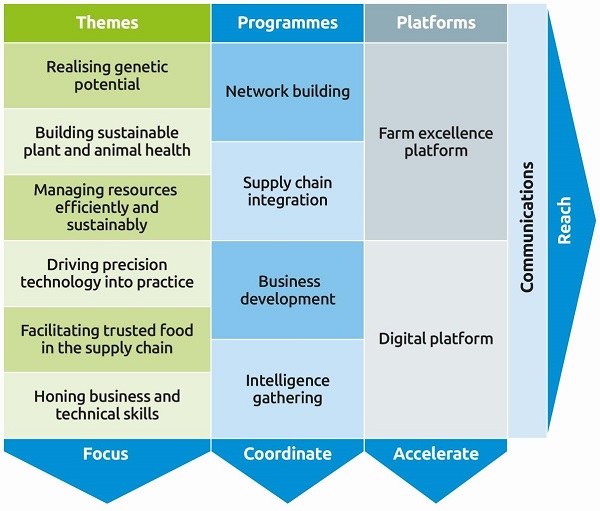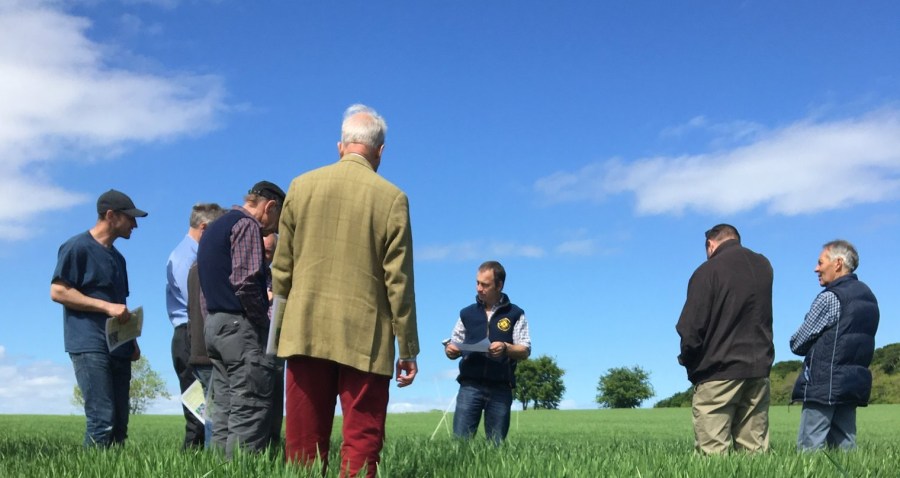On-farm collaboration is where AHDB is focusing its research and knowledge exchange funding. CPM reports.
We know that farmers learn best from each other.
By Tom Allen-Stevens
Prepare for a new approach to research and knowledge exchange (KE) from AHDB, and one that makes more use of ‘you’.
That was the message from AHDB’s chief technical officer Richard Laverick who outlined the levy-funded programme of research activities over the next three years to around 60 stakeholders from universities and research centres at a meeting near Nottingham last month.

The AHDB research and knowledge exchange framework
“We’re making fundamental changes to the way we deliver R&D and KE,” he said. “A core part of this is the farm excellence platform and we know that farmers learn best from each other. The AHDB Monitor and Strategic Farms are very important to us, and we want to expand this network to around 60 – 30 of each.”
The new framework comprises six themes, delivered through four programmes (see below). These focus on two “dynamic and proactive” platforms, with a digital platform set to work alongside AHDB’s existing farm excellence network. This signals a determined move by AHDB to use new techniques to accelerate uptake of levy-funded research on farm.
Noticeable by its absence in the new themed approach is any mention of sectors, such as Cereals and Oilseeds or Potatoes. But this is quite deliberate, explained AHDB research director Dr Bill Parker. “It’s our strong intention to create a one-AHDB technical umbrella,” he said.
He sketched out how the themes would take shape:
- Realising genetic potential. The AHDB Recommended List is a good example here. It’s the single biggest project undertaken in crops and is held up as an area where R&D and KE work well together.
- Building sustainable animal and plant health. This is the biggest single theme of the lot and encompasses resistance management. The fungicide performance work in wheat is seen as the “backbone of product choice” for cereal growers, said Bill Parker.
- Managing resources efficiently and sustainably. The biggest project in this area is the soils platform (see article on p36). It also encompasses the crop storage work at Sutton Bridge Experimental Unit.
- Driving precision technology into practice. Data management is the key priority as the ability to gather it is burgeoning, but the “crux” is what that data’s telling you. It’s a “huge knowledge gap” AHDB aims to fill.
- Facilitating trusted food in the supply chain. Grain quality and safety research falls into this theme, and there’s an increasing requirement to monitor this, noted Bill Parker.
- Honing business and technical skills. Benchmarking forms the basis here, and the “social science” challenge for AHDB is to drive farmers to change.
How AHDB spends its £65M annual income is set to change over the next three years as this farmer-to-farmer emphasis pulls through. The 44% share of the budget currently spent on research and KE will remain the same, but the core research budget will be reduced with KE expenditure rising from 14% to 21% of the total by 2019/20. Cereals and Oilseeds is set to see the biggest jump in KE funding, with a tripling in the current 8% allocated to an estimated £2.7M, while AHDB Horticulture will also ramp up KE activities from 10% to 26% of its £7.7M total budget.
The message from Bill Parker for those looking to tender for projects from AHDB was clear: “We’re looking for larger, longer, cross-cutting programmes and they need a KE element at the outset. They should make use of collaboration.”
On the arable side, it’s the network of 22 Monitor Farms that sits at the heart of this collaboration and will play a key role in delivering the four KE programmes. AHDB Cereals and Oilseeds has recently revealed plans to roll out three Strategic Farms over the next three years, with the first one – Lodge Farm in Suffolk, home to Brian and Patrick Barker – announced earlier this summer. There are four AHDB Potatoes SPoT farms.
AHDB KE director Dr Susannah Bolton told CPM there are real opportunities to work with this network to bring forward more innovations in agriculture and accelerate the pace of technical advance in agriculture. “These farms are an extraordinary and valuable resource with a real connection to farm businesses and they represent a new model of farm participation.
“Moreover, they’re a great demonstration of farmer innovation. The key is the farmer who can present information in a way that is accessible to other farmers. These individuals become the ambassadors for farming and drive innovation.”
In a typical year, AHDB delivers over 500 technical workshops or farm events and teams engage regularly with more than 170 discussion and business groups.
Hub to raise profile of British barley
Hopes are growing that a proposed new International Barley Hub, based in Scotland, will support material expansion of the world-leading barley research already undertaken at the James Hutton Institute in Dundee. The hub will be a partnership involving JHI, other research organisations and industry, and aims to facilitate greater impact from research activities at industry and economic levels. The project has made a bid for a £40m initial investment from the £1.8bn Tay Cities Deal which will fund the hub until it’s financially stable in year seven.
“This would be an investment coming from outside agriculture but it would be of huge benefit to farmers,” notes JHI director and chairman of Scottish Agronomy George Lawrie.
The money would be spent on a new centre with up-to-date labs and equipment that’ll bring together over 100 scientists dedicated to developing the breeding, agronomy and end uses of the crop. It’s estimated the hub would add around £800M/year to the UK economy through its support of industries such as farming and brewing, and whisky, the biggest single UK food and drink export, worth £5bn/year.
“Maltsters are looking for a more reliable variety that’ll produce the 1.5-1.7%N grain they’re after. We’re the best country at producing barley, but don’t use it to the same extent as others in foods, such as baking and biscuits, and there are opportunities to enhance and promote its health value, in a similar way to oats,” says George Lawrie.
“We have all the scientific and technical expertise and just need to bring it together. The opportunities for what we can do lie not just in the UK or Europe but around the world.”
One in particular is in Ethiopia, where demand for barley, particularly for brewing, is growing rapidly but there are no varieties well suited to the climate and end uses. “Heineken is looking at how it can fulfil the demand, but we can take it a step further. We can develop a variety that’s both more drought-tolerant and delivers the spec they’re looking for,” he suggests.




